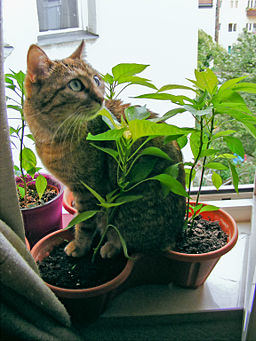The American Society for the Prevention of Cruelty to Animals (ASPCA) performs many well-meaning services, and among them is
listing on their website the houseplants that are toxic to dogs and cats who may chew on or ingest them. It’s alarming to read just how many houseplants can be dangerous to pets, and of course to small children as well, who similarly are drawn to taste testing unfamiliar plants. Reading the list, one comes to the conclusion that the only truly safe solution lies in ridding the household of plants entirely.
 The photographer’s cat, Emmy, sits among houseplants. Photo by Wikimedia user Mattes.
The photographer’s cat, Emmy, sits among houseplants. Photo by Wikimedia user Mattes.
Closer examination of the information available on the ASPCA website and
elsewhere reveals that such drastic measures are unnecessary. Houseplants (as their very name implies) have coexisted with adult humans, their pets, and even small children for centuries without calamity. Two factors account for the relatively peaceful, if not entirely harmonious, relationship of flora and fauna under one roof.
One factor is the
mostly small amount of toxicity present in almost any plant you care to name, and the other is the common sense tendency of most creatures to cease nibbling on a plant that tastes unpleasant before ingesting a poisonous quantity. Plants manufacture toxins because they are a defense against nibbling animals. A toxin is not deadly in small amounts, while a poison is deadly in any amount. Production of poisons uses up more of a plants’ resources than production of toxins, and therefore plants have generally evolved to ward off nibbling creatures with unpleasant toxins rather than deadly poisons.
This explanation is an oversimplification of the state of affairs, but suffice it to say that if the situation were otherwise, unfortunate humans and animals would be dropping dead to the point of depopulating the planet. They are not. Toxins of some kind are present in most plants, indoors and out, but they exist as a warning to animals not to eat too much of the plant, and thus destroy the plant’s ability to make a living. On the scale of toxic household chemicals, houseplants overall probably weigh in favor of improving the health of people and pets since many of them do valuable service in cleaning the air. Still, no one can fault people for exercising caution when their children or animal friends are at risk, but only for acting heedlessly in reaction to insufficient information.
— Izzy 


